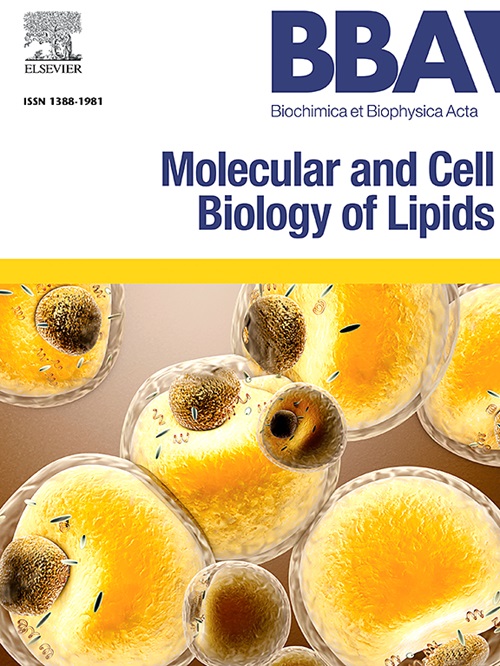年龄相关的心磷脂谱变化和脂肪酸供应改变的功能后果。
IF 3.3
2区 生物学
Q2 BIOCHEMISTRY & MOLECULAR BIOLOGY
Biochimica et biophysica acta. Molecular and cell biology of lipids
Pub Date : 2025-09-07
DOI:10.1016/j.bbalip.2025.159687
引用次数: 0
摘要
心磷脂(Cardiolipins, CLs)主要表达于线粒体内膜,在线粒体膜结构和线粒体功能中起重要作用。CLs具有独特的结构,其特征是四个酰基链具有不同的化学计量,如链长和饱和度。CL组成随疾病和年龄的变化而变化,但动态变化如何影响线粒体功能在很大程度上是未知的。在这里,我们使用液相色谱法和三重四极杆质谱法比较了不同年龄组的不同小鼠组织中的CL谱。一个关键的发现是,大脑中的CLs与周围器官中的CLs有很大的不同,它们倾向于长链变异。我们假设这些差异可能受到脂肪酸(FA)可用性的影响,而脂肪酸在大脑中可能受到血脑屏障的影响。为了支持这一观点,我们发现FA浓度在不同的隔室中有所不同。此外,我们发现随着老化,CL谱发生了变化。在补充不同FAs的培养巨噬细胞中,我们分别测试了CL谱的改变对线粒体形态和功能(如嵴密度)、线粒体膜电位和呼吸的影响。最后,我们通过使用富含棕榈酸和油酸的饮食改变小鼠的CL谱,在体内验证了我们的体外结果。我们的研究强调了CL谱对FA可用性和衰老的动态适应,并强调了其对线粒体功能的功能重要性。此外,补充FA可能是一种有希望的治疗策略,以解决疾病和年龄相关的线粒体功能障碍。本文章由计算机程序翻译,如有差异,请以英文原文为准。

Age-related changes in cardiolipin profile and functional consequences of altered fatty acid supply
Cardiolipins (CLs) are primarily expressed in the inner mitochondrial membrane where they play essential roles in membrane architecture and mitochondrial functions. CLs have a unique structure characterized by four acyl chains with different stoichiometries such as chain length and degree of saturation. CL composition changes with disease and age, but it is largely unknown how dynamic changes affect mitochondrial function. Here, we compared CL profiles in different mouse tissues across different age groups using liquid chromatography and triple quadrupole mass spectrometry. A key finding was that CLs in the brain differ significantly from those in peripheral organs, with a tendency towards longer-chain variants. We hypothesized that these differences may be influenced by the availability of fatty acids (FA), which in the brain could be affected by the blood-brain barrier. In support of this notion, we found that FA concentrations varied in the different compartments. In addition, we found that CL profiles changed during aging. In cultivated macrophages supplemented with different FAs, we tested how altered CL profiles may affect both, mitochondrial morphology and function such as cristae density, and mitochondrial membrane potential and respiration, respectively. Finally, we validated our in vitro results in vivo by altering the CL profile in mice by using palmitic acid and oleic acid enriched diets. Our study highlights a dynamic adaptation of CL profiles in response to FA availability and aging and emphasizes its functional importance for mitochondrial function. Furthermore, FA supplementation may be a promising therapeutic strategy to address disease- and age-related mitochondrial malfunctions.
求助全文
通过发布文献求助,成功后即可免费获取论文全文。
去求助
来源期刊
CiteScore
11.00
自引率
2.10%
发文量
109
审稿时长
53 days
期刊介绍:
BBA Molecular and Cell Biology of Lipids publishes papers on original research dealing with novel aspects of molecular genetics related to the lipidome, the biosynthesis of lipids, the role of lipids in cells and whole organisms, the regulation of lipid metabolism and function, and lipidomics in all organisms. Manuscripts should significantly advance the understanding of the molecular mechanisms underlying biological processes in which lipids are involved. Papers detailing novel methodology must report significant biochemical, molecular, or functional insight in the area of lipids.

 求助内容:
求助内容: 应助结果提醒方式:
应助结果提醒方式:


